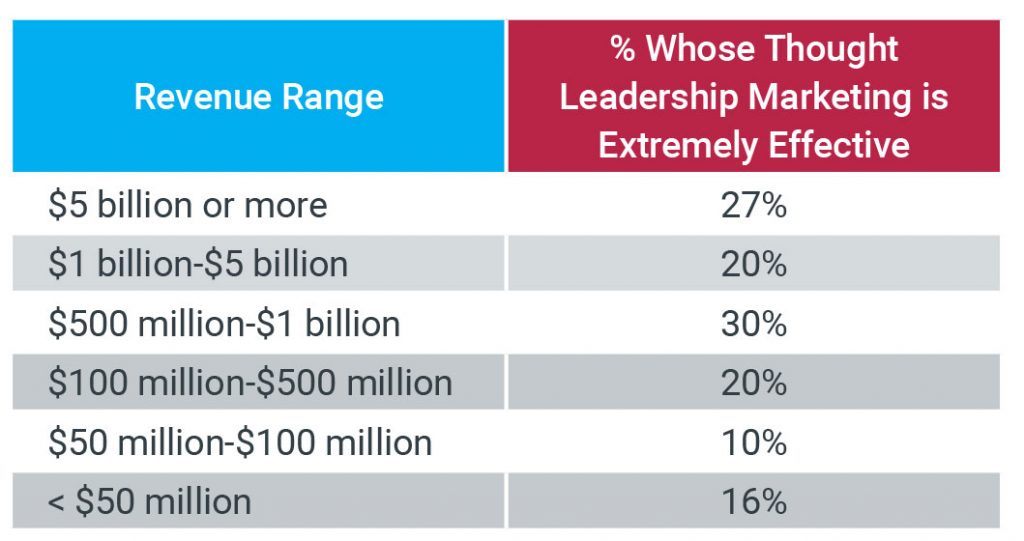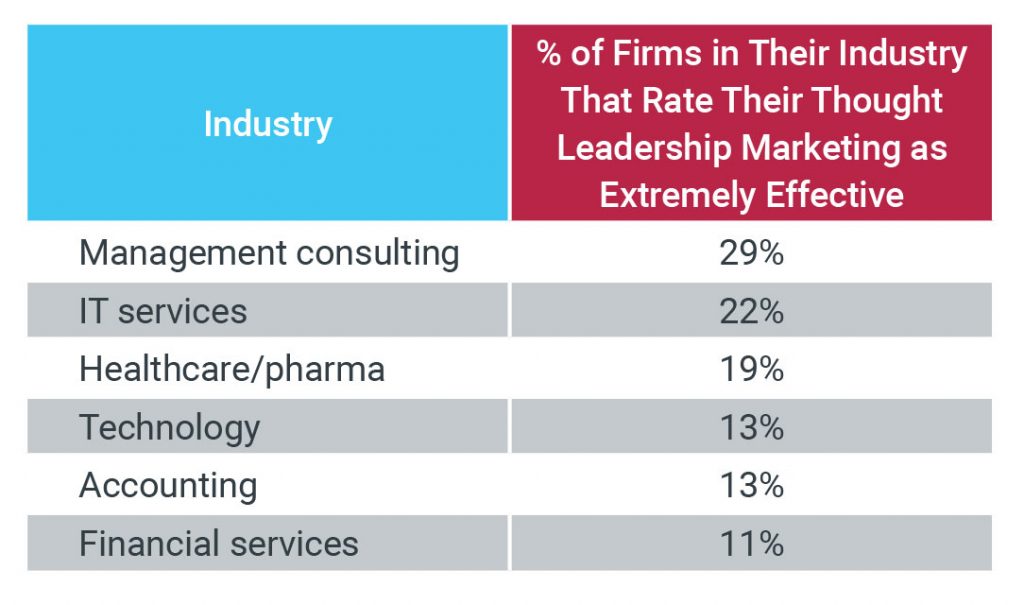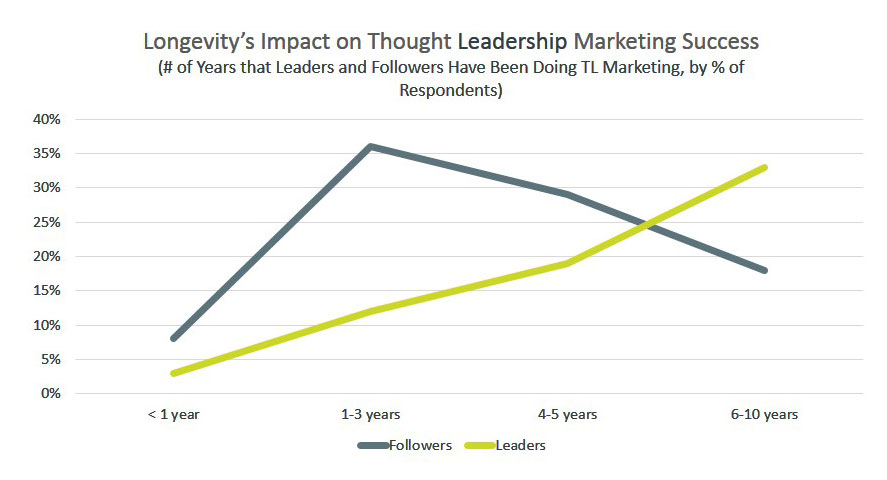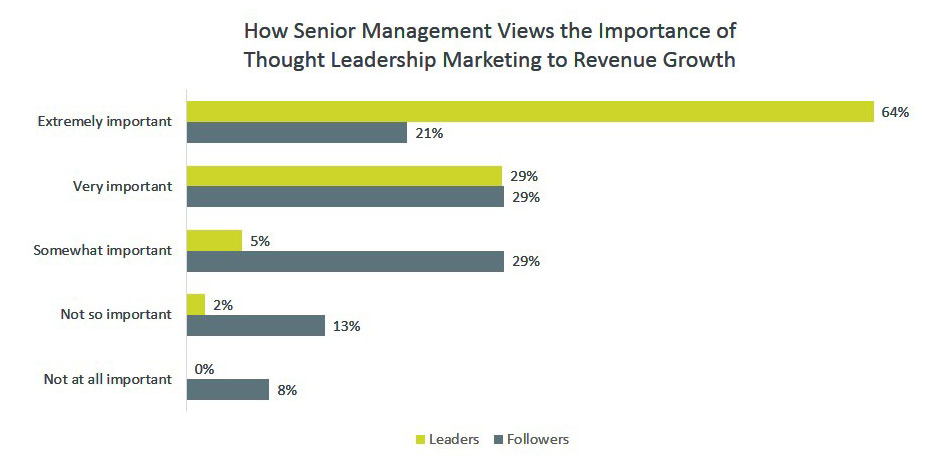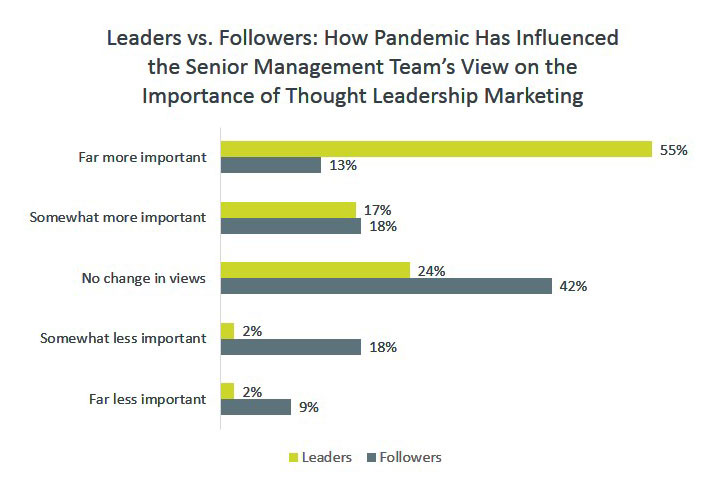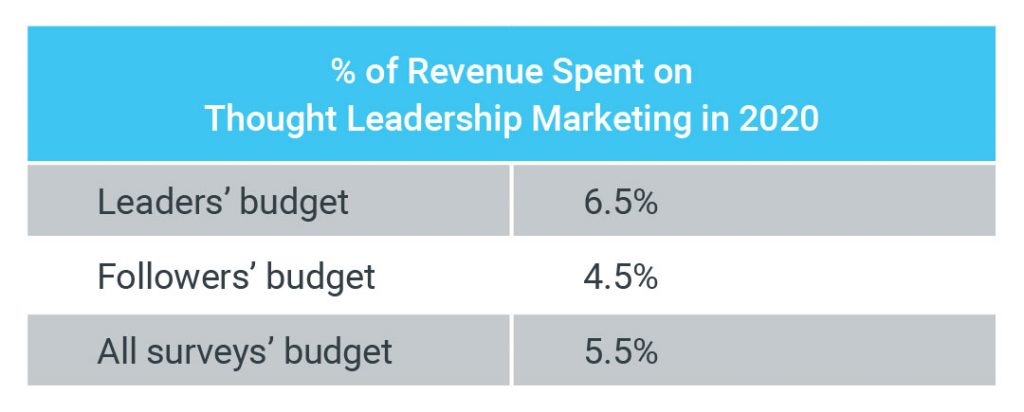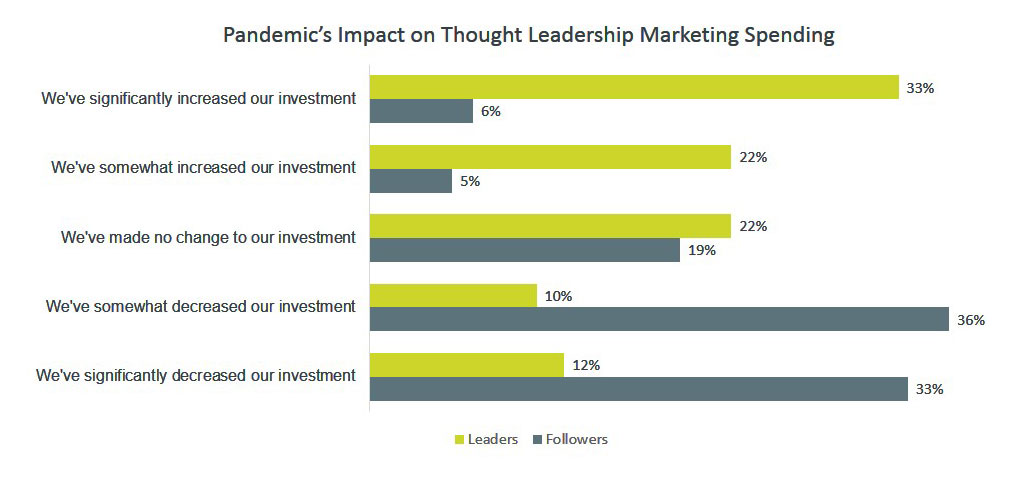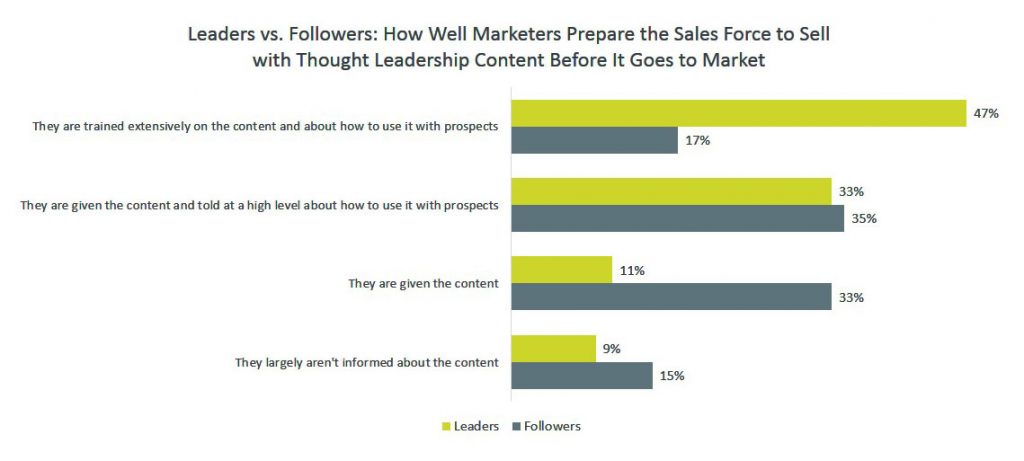The Advantages of the Best Thought Leadership Marketers
The first competitive edge that the most effective thought leadership marketers have, on the surface, may sound basic. Maybe even banal. It’s that they have is a much better idea about helping top management decide where to funnel thought leadership resources in the organization – i.e., to the places where the organization needs them the most (especially in large firms).
This is about having a solid thought leadership strategy. The majority of leaders have what we see as the key elements of such a strategy (especially, agreement on the client pain points they need to “own” and how to allocate investments across the firm). The followers usually did not.
In our experience, B2B firms use their thought leadership resources most wisely when they allocate them in proportion to the revenue contribution and growth potential of their service offerings. If Practice A (the biggest practice) represents 40% of total revenue and four smaller practices account for the remainder, shouldn’t Practice A get somewhere around 40% of the total thought leadership budget? The answer would be yes – unless those other practices (or a new service offering) can make a strong case that they have greater growth potential than Practice A does, and that thought leadership is a key factor in achieving that growth.
All to say that companies need to get thought leadership spending in line with their overall service line spending, adjusted for the growth potential of other existing or new services. This is how the best thought leadership marketers that we surveyed think – or at least 60% of them do. (See Exhibit 9.) In stark contrast, only one in six of the least effective thought leadership marketers work think along these lines.
With that in mind, it may not be surprising that more than three times as many leaders than followers believe their firms allocate their investments in the proper amounts.
EXHIBIT 9: LEADERS ARE MORE SURGICAL IN THEIR SPENDING

We know that making such wise allocations is much easier said than done. On countless occasions, we have seen companies’ service line or regional budgets for thought leadership marketing not having any rhyme or reason. One service line gets twice the budget as another service line, even it has half the revenue and small growth potential.
This typical happens when a) thought leadership strategy is not tied to offering (services and products) strategy, and b) thought leadership budget authority is buried in services and practices to a greater extent.
But it can also happen at companies whose centralized thought leadership marketing groups opt to work with people and practices that are easier-to-play with – e.g., those who have more people with time to devote to creating compelling content (and sometimes writing skills that match their thinking skills).
Still, that doesn’t necessarily result in the right allocation of thought leadership resources. If Practice A (which represents 40% of the firm’s revenue and has great upside potential) is only getting 10% of the firm’s total thought leadership budget, Practice A doesn’t have command of the resources it needs to grow. And what if a new practice – Practice X in our hypothetical example – has great opportunity but, of course, zero revenue to begin. It may need primary thought leadership research based on best practices in the marketplace to be able to get an intellectual toehold in the market for mindshare.
In short, the best thought leadership marketers help senior management get a better handle on how the firm’s thought leadership dollars should be allocated, and (as important) why they should be allocated that way.
Putting Content and Marketing on Equal Pedestals
Ask a marketer to explain the key factor behind their company’s success in thought leadership marketing and you may get an answer that has to do with marketing – i.e., the great campaigns they planned and executed. Ask a thought leadership researcher or editor what they thought was the key to success, and they’ll likely say it was great content – a study or article with a breakthrough concept. As the thought leaders themselves – the company’s experts who author the content – and they’ll naturally think it was their ideas that carried the day. Not surprising. As John F. Kennedy once said, “Victory has a thousand fathers.” (He concluded that statement with “but defeat is an orphan.”)
It would be natural to assume that marketers believe it’s their work that is the key to thought leadership success; indeed, everyone likes to take pride in their work. Our research confirmed that this happens in thought leadership. When we asked our 314 respondents – three-quarters of them marketers — to rate the most important among four factors behind their best campaign since 2018, one stood out above all the others: marketing programs that attracted viewers to their firms’ website content. Nearly twice as many (51%) chose that over the second-ranking factor: exceptional content. Only 28% said great content ruled the day.
The differences in views on this between the most and least effective thought leadership marketers was substantial. The top-rated factor for the “followers” in thought leadership marketing were marketing programs. More than twice as many followers pointed to that (59%) than pointed to exceptional content (27%), their second-ranked choice.
Now contrast that with what the “leaders” at thought leadership marketing felt was most important. A much more balanced number cited marketing (40%) as cited content (38%). Had we polled an equivalent number of editorial people as marketers (and thought leaders themselves), we believe that the majority would have ranked content as tops. (Of the 314 survey takers, 20% were in editorial jobs and 5% had other roles.) (See Exhibit 10.)
EXHIBIT 10: THE CONTENT VS. MARKETING DEBATE
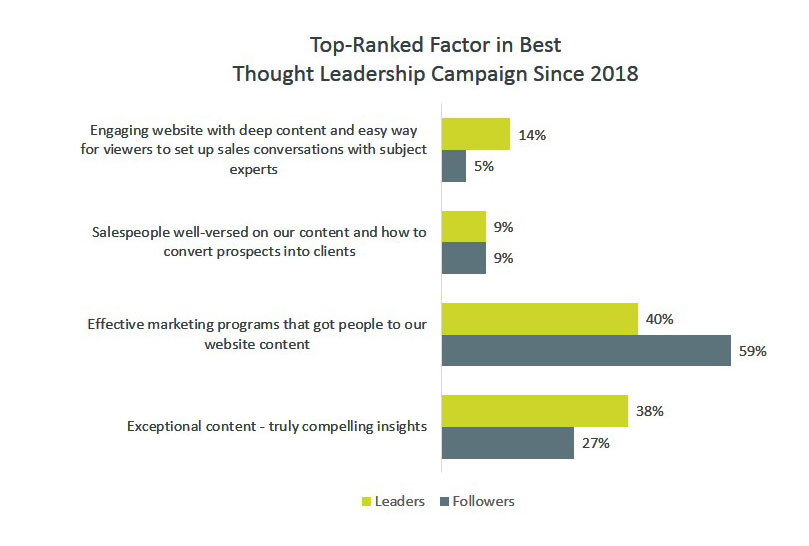
At this point you might well be asking, “Why does this matter? Who cares whether marketing, editors or our thought leaders take the bulk of the credit?” Actually, we think it does matter – greatly. For years, we have seen that when B2B firms take a marketing-centric view of thought leadership – in short, that it’s the marketing of the content that counts most, not the content itself – they unwittingly create conditions that make it difficult to compete on thought leadership.
Why do we believe this? We see three primary reasons why a marketing-centric view of thought leadership can result in too-often inferior content:
- What makes for great content often is not widely understood. Firms aren’t likely to apply exacting quality standards to their content. Their standards are low. And if they have high standards, they don’t enforce them.
- Content development can get a superficial treatment: Content tends to be viewed, more or less, as just “stuff” to pump through marketing campaigns, which leads to insufficient time and skills applied to try to turn “OK” content into compelling content.
- Internal experts are more likely to resist marketing’s help to make their content better. Aspiring thought leaders can come to believe that the firm’s marketers will publish virtually anything they send to them (with a little editing “polish”). Or internal thought leaders may feel marketing can’t help them much and thus will resist marketing’s suggestions on how to make their content better (especially requests for substantial changes).
The most effective thought leadership marketing happens in companies that take what we call a content-centric approach of thought leadership. In these firms, exceptional content is their True North, their holy grail, their guiding light. They put profound and inarguable arguments on their pedestal. And they know what’s required to make those arguments, especially best-practice case study examples (learned first-hand) that prove the efficacy of their solution, among several factors. In other words, these firms know the tests of high-quality content – of clear and unassailable arguments. And their content regularly passes those tests.
One of the biggest differences that we found between leaders and followers was the self-assessed quality of their firm’s content. More than 2½ times as many leaders than followers felt their thought leadership content was of high-quality (which we defined simply in the survey as providing new insights to the marketplace). (See Exhibit 11.)
EXHIBIT 11: THE LEADERS’ CONTENT ADVANTAGE

This is not to say that the best thought leadership marketers minimize the value of good marketing. On the contrary: They know that building the right audience for their content is critical, and very difficult. But they also know that without compelling content, even extensive marketing is likely to disappoint. Let’s look at what how these leaders operate.
How Leaders Take a Content-Centric Approach to Thought Leadership
After a B2B firm has a clear thought leadership strategy – i.e., most of all, what clients and client pain points to focus its content – the two most important elements of a content-centric approach are a) setting and enforcing quality standards and b) establishing a rigorous content development process.
Both leaders and followers are likely to have content quality standards (every leader had one; 85% of followers did too). But more than four times as many leaders than followers empowered thought leadership editorial or marketing professionals to enforce those standards. In other words, when a company expert’s paper didn’t meet the firm’s standards, thought leadership marketing pros could reject it without consequences. Nearly a third of followers had quality standards that weren’t enforced. That suggests lots of subpar content is getting published in these firms. (See Exhibit 12.)
EXHIBIT 12: EXAMINING THE CONTENT QUALITY SCREEN
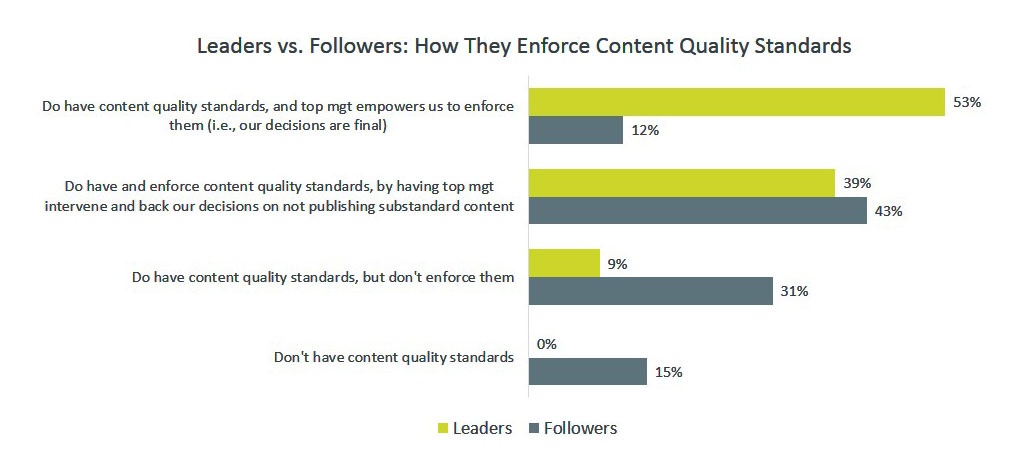
With explicit standards in place, the next key piece to helping their firm’s current and aspiring thought leaders should be helping them meet those standards. In the best thought leadership functions that we know, marketing and editorial people behave much differently than their counterparts in less-effective thought leadership groups. The biggest difference has to do with the liberty they give thought leadership professionals to taking a strong hand in shaping the arguments that their firm’s experts are trying to make in their articles, speaking presentations, blog posts and other content.
In leading practitioners of thought leadership marketing, argument-shaping is a more prevalent and more developed skill. We’ve seen this behavior in conducting surveys of thought leadership professionals for more than 10 years. We saw it again in this survey: marketing and editorial people work with subject experts to first create outlines before anyone pens prose. And it’s marketing/editorial people who create the outline – not the subject experts whose names will go on the final product as authors. Some 51% of leaders produce article content this way vs. 41% of followers.
That may not seem like a huge difference, and it’s not. But where leaders stood out in creating outlines was in using structured outlines – outlines that follow a familiar logic path (e.g, problem > solution, or situation > complication > resolution, or some other way of introducing tighter logic and flow to an argument in the making). Three times as many leaders (25% in all) use such structured outlines to guide the argument. (See Exhibit 13.)
EXHIBIT 13: LEADERS PLAY A STRONGER ROLE IN SHAPING ARGUMENTS

The fact that only about half the leaders use outlines in shaping articles, and only half of those leaders use structured outlines, tells us there’s big opportunities for improvement on this front. In helping clients develop and place dozens of opinion articles in the most prestigious publications in the world as earned media (Harvard Business Review, Financial Times, MIT Sloan Management Review, BusinessWeek and many more), we have found a structured outline approach to developing content to be essential.
It helps marketers and editorial people take control of the content development process without telling their company’s experts what to say. It gives them a way to turn too many unstructured and unproductive conversations into highly structured and productive ones. Without a structured outline template, it can be very difficult to get very smart people to focus their thoughts in ways that an audience can understand them. Unlike times when they’re in meetings with clients and prospects – times in which they can ask the experts to explain unclear items — readers of published content don’t have that opportunity. The writing must express persuasive, logical, fact-based and clear arguments.
Thought Leadership Research as Content Turbocharger
What are the core elements of highly successful thought leadership campaigns? Do you need primary research? Or would a deep white paper be enough? Or how about an article in a prestigious journal, one that conveys “you’ve arrived”? Or maybe it’s a book?
We compared how leaders and followers answered this question: What were the key content assets of their most successful thought leadership campaign of the last three years? We had them choose from four options, with the ability to choose any or all of them, or to indicate “other.” Here we saw that for three of the four options, at least 49% of the leaders pointed to them (research studies, white papers and op-eds in top-tier journals). But less than half the followers used any of the four, and the minority (47%) used the most frequently cited content source of the leaders: primary research. (Exhibit 14.)
EXHIBIT 14: THE LEADERS’ PASSION FOR PRIMARY RESEARCH
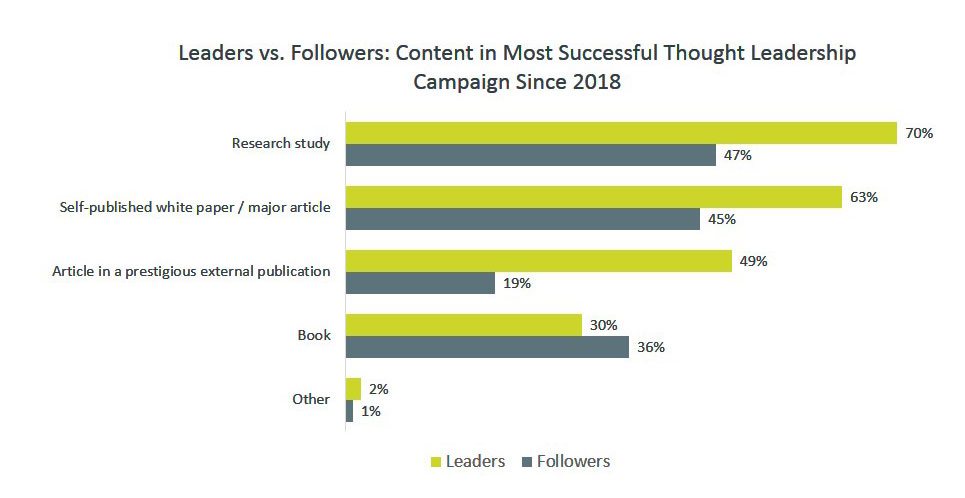
Primary research is vital to producing groundbreaking ideas. But not all such research yields that. What does? The leaders gave us one clue: designing research to learn whole new things vs. designing it to confirm what a firm already believes. Those two are very different approaches to research design. The majority of the leaders (56%) said they design their studies to create whole new insights and approaches to solving an issue; only 47% of the followers said the same.
Companies that are serious at competing on thought leadership know that primary research is a requisite that can produce bold new ideas, approaches to delivering their services and even whole new services. But how did the leaders and followers compare in their approach to such research? In a word, the leaders placed similar emphasis on primary research as they did on their field experience with clients. In other words, they viewed their client projects as more research data points. When asked to select the one most important type of research behind their most successful thought leadership campaign since 2018, 44% of leaders said it was surveys or best-practice interviews. Another 40% said it was capturing the client experiences of their people. (See Exhibit 15.)
In contrast, only 23% of the followers said their client experience was the most important type of research for creating thought leadership content. Some 70% said surveys or interviews with best-practice companies were their best type of research.
What does this mean? In our view, it means that B2B firms should design thought leadership research studies that include their clients and the projects they do with them, in addition to studying other organizations for sure. Using client experiences and best-practice interviews with other organizations gives a firm deep qualitative research. Such qualitative research makes it easier to understand what factors on any topic separate the best at solving the problem from the rest. Structured surveys can also provide statistical data on these differences as well (if they’re structured well to separate “leaders” from “laggards” on the topic).
However, only one in eight leaders said such quantitative surveys were their most important type of thought leadership research. In our view, the time is coming fast to recognize the limitations of such surveys.
EXHIBIT 15: EXPANDING WHAT COUNTS AS THOUGHT LEADERSHIP RESEARCH
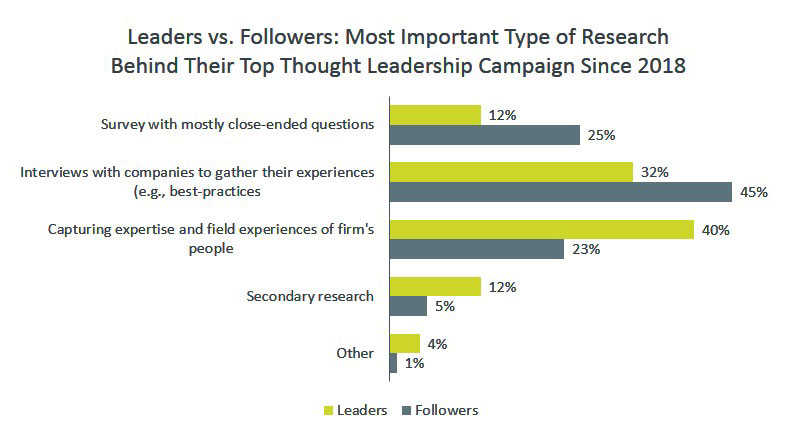
Drawing on a firm’s field experience as a source of best practices not only enriches the research data pool. It is likely to draw a firm’s experts more tightly into the research process. With company experts helping marketers design and analyze the findings, those experts are more likely to take the content into the field because they truly see the advice as their own.
Marketing Goes Far Beyond the Written Word
With more than 20 years of Web experience and a more than a decade of social media marketing in attracting audiences to their content, many B2B companies have mastered online tools. But the leaders of our survey use more of them, and they also are more likely to supplement their written content with audio (podcasts), live video and other content.
Such audio and video content makes their experts more “real” – they can be heard and seen, not just read. At least 40% of the most effective thought leadership marketers’ best campaigns used five tools to build their audience:
- Op-ed articles in external publications
- Website blogs
- LinkedIn articles
- White papers/e-books published on their websites
- Web or live-streamed videos
In contrast, the only marketing tool used by at least 40% of the followers was op-ed articles. In short, leaders use more of these tools in their campaigns, and they are much more likely to go beyond the written word. (See Exhibit 16.)
We believe that viewing thought leadership marketing activities as, more or less, publishing activities comes from having a print mindset dominating one’s thinking. (We once had that mindset, too.) A print mindset is one that believes prose is the best way to communicate highly complex ideas, that clients largely buy logic and not emotion or chemistry.
Our findings on the marketing campaigns of our leaders at thought leadership speak otherwise. They show a thought leadership marketing toolkit that is as much about highly persuasive articles and research reports is it’s about seeing and hearing the passion of the thought leaders.
Especially during this pandemic, when it’s impossible for many B2B company experts to meet with clients and prospects, it’s important for a firm to utilize tools that convey its personality and passion, not just its expertise. The top firms are showcasing their experts in webinars, videos and podcasts as well as in the written word.
EXHIBIT 16: BREAKING THE PRINT MINDSET AND RELYING LESS ON PROSE
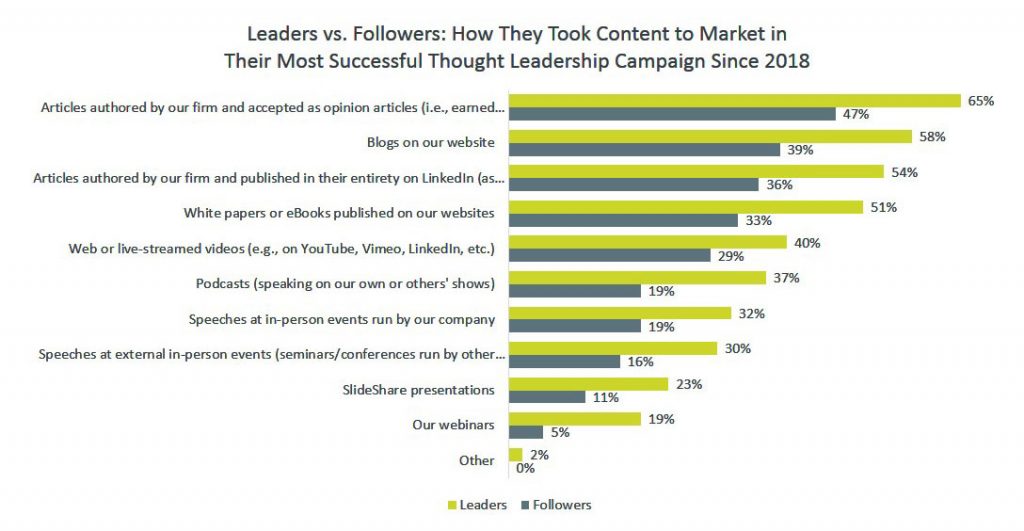
Note a very important content tool in the marketing mix shown in the above chart: op-eds in external publications. This was the most frequently used format of leaders at thought leadership marketing – nearly two thirds of them. The question is why. The way we see it, in a world of proliferating content, “earned” media has become a crucial tool in the thought leadership professional’s toolbox. (Earned media signifies that a publication editor approved it as worthy to run as an editorial.
That is quite different from “paid” media such as advertorials, where publications will run just about anything as long as an advertiser pays for it).
Getting prestigious publications to run a thought leader’s opinion articles brings the credibility: the endorsement of an esteemed publication. Those such as Harvard Business Review, MIT Sloan Management Review, and The New York Times op-ed page publish a tiny percent of the articles they receive. The leaders in our survey were far more likely to recognize the value of such earned media. (See Exhibit 17.)
EXHIBIT 17:
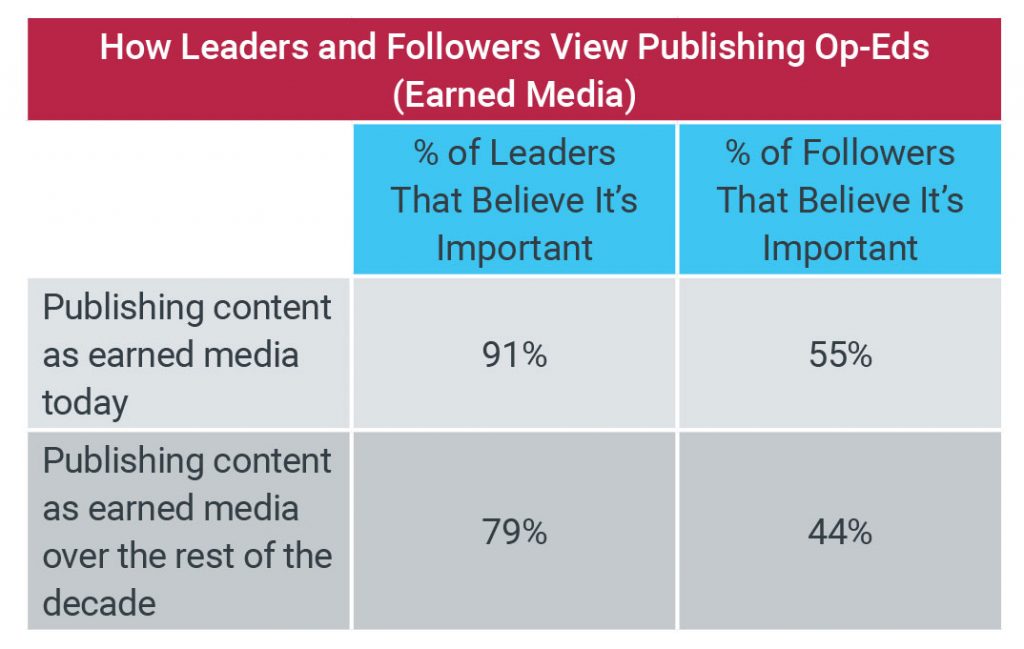
Not only are leaders at thought leadership more video and audio-oriented; they are more data visualization-oriented.
If you haven’t heard that term, what does data visualization mean? Perhaps you’ve seen the elegant COVID graphs on The New York Times or Washington Post websites. Maybe you’ve been drawn into those interactive “scrollytelling” stories, in which pictures, videos and/or graphs and charts appear and disappear as you peruse an article online. These are early examples of the data visualization revolution that is just beginning to re-shape how thought leadership marketers present online content.
Our study found, perhaps not too surprisingly, that the leaders at thought leadership marketing are way ahead on this front. Nearly twice as many leaders as followers have interactive surveys that let users compare their results against others. More than half of leaders, and only a third of followers, have interactive charts that allow viewers to filter the results. And more leaders are using scrollytelling to bring their stories to life. (Exhibit 18.)
EXHIBIT 18: DATA VIZ IS HAS ENTERED THE VIRTUAL BUILDING
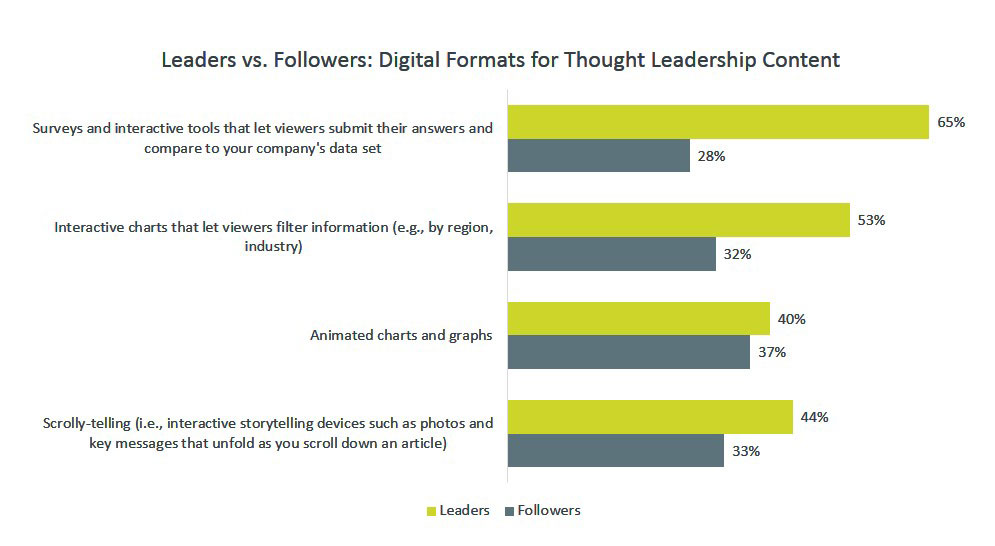
You can lump all of this – and more to come – under the umbrella term “data viz.” We believe it will be one of the most exciting places to compete on thought leadership this decade, given the complexity of the topics and the need to simplify the complexity with more than words.
How do thought leadership marketers get viewers to their websites? Few B2B firms enjoy the luxury of being destination sites that people visit regularly and without any prompting. How do thought leaders get the right people to view the thought leadership content on their sites?
We asked survey respondents to tell us what promotional tools they used in their best campaigns over the last three years, offering eight choices. Leaders are much more likely to use seven of the eight tools. And the majority of them used four tools to drive website traffic in their most successful campaign: email newsletters, advertorials, social media posts, and press mentions of their content (from good-old-fashioned PR outreach). And nearly half use social media advertising. (See Exhibit 19.)
EXHIBIT 19: BUILD IT AND THEY WON’T COME SOON

In stark contrast, the majority of followers did not use any of the eight promotional tools.
What to make of this? Don’t expect huge numbers of the right people to view even exceptional content on your site. “Build it and they will come” is not likely to happen with thought leadership – at least, not quickly. Like a great new restaurant in an out-of-the-way location, thought leadership content that’s not promoted well is content that only your firm and its clients are likely to know about.
